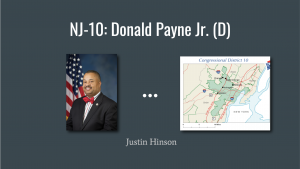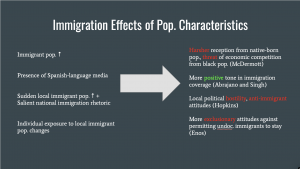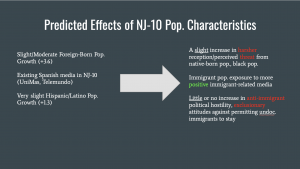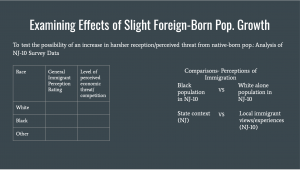
New Jersey Congressional District 10, represented by Donald Payne Jr. (D)

Over the course of the ten year period from 2007 to 2017, NJ-10 experienced a moderate growth in its foreign-born population, from comprising 26.3% of the total population to 29.9%. While whites and races classified as other experienced slight declines in population size, the black majority in NJ-10 experienced a more significant population decrease, from 56.9% to 51.7%. Asians and Hispanic/Latino populations were the only groups to increase over the ten-year period, with Asians featuring a larger rise in population from 4.5% to 7.6%. Asian and Hispanic/Latino population growth from 2007 to 2017 indicates the rise of Asian and Hispanic/Latino immigrant populations, following the growth of the foreign-born population during the ten-year period as well. Whites in NJ-10 relatively stayed at the same population, suggesting that there wasn’t much of an effect to the increasing immigrant population. However, blacks experienced the most amount of decline, indicating the inhibitory effect of increasing immigrant populations who most likely contributed to the competition of jobs and wages in a low-wage labor market.

As the size of an immigrant population increases, this growth can be met with a increase in harsher reception from the native-born population, assuming that the immigrant population is primarily Asian and Hispanic/Latino (McDermott, 2013). The reaction of the native-born population to a growing immigrant population can affect the ability of immigrant groups to become socially and politically integrated, developing fear and anxiety about hostile opposition from native-born groups. Due to increasing racial salience in the social context of an increasing immigrant population size, whites and blacks may strengthen their racial identities to set social distinctions between different immigrant groups and native-born groups (McDermott, 2013). In a growing immigrant population, the presence of Spanish-language media can influence the public exposure to different perspectives and views regarding immigration. While both Spanish and English national news are neutral in their take on immigration, Spanish local and national news tend to discuss immigration in a more positive tone more frequently than English local and national news (Abrajano and Singh, 2008). This can provide Hispanic/Latino immigrant groups who follow Spanish news media with greater exposure to positive perspectives and views on immigration. Local attitudes on immigration can be impacted by sudden demographic changes in immigrant population and salient national rhetoric which negatively portrays immigration (Hopkins, 2010). As a result, individuals exposed to local immigrant growth can develop anti-immigrant political hostility. In addition, exposure to demographic changes at the local level can immediately create exclusionary attitudes and opposition to permitting undocumented immigrants from residing in the US (Enos, 2014). Despite only slight changes in immigrant population on the state level, individuals who observe immigrant population growth on the local level can develop more exclusionary and anti-immigrant attitudes.

Given NJ-10’s moderate growth in foreign-born populations as well as Hispanic/Latino and Asian populations, this district can experience a slight increase in the development of hostile attitudes and harsher reception towards these immigrant groups from the native-born population. The existence of a black majority in NJ-10 that experienced a more significant decline in population can be highlighted as a native-born group that may develop more anti-immigrant attitudes compared to whites or other races. In addition, the presence of increasing economic competition between working-class blacks and immigrant groups can be attributed to the development of increasingly hostile attitudes from African Americans towards immigrant groups. This demonstrates the greater effect of the local influence of immigrant population growth, as individual exposure to immigrant groups in local communities can cause more hostile attitudes despite only a moderate growth of the immigrant population in the district. Media influence can also be affected by population characteristics in NJ-10, where Spanish-language media is present and available in local communities. These news stations include UniMas, Telemundo, and Television, providing a variety of broadcast options for local immigrant groups. The presence of Spanish media allows for Hispanic/Latino groups to gain exposure to news reporting that discusses immigration in a more positive tone, and portrays different perspective and views on immigration compared to American national and local news stations. Despite the minimal predicted increase in perceived threat and hostile attitudes towards immigrant groups in NJ-10, sudden demographic changes on the local-level along with salient national rhetoric can bring more exclusionary attitudes and opposition to undocumented immigrants residing in the US (Hopkins, 2010). A declining black population combined with increasing Asian and Hispanic/Latino populations can influence more exclusionary attitudes at a greater effect than just the slight foreign-born population increase. The existence of salient rhetoric in national media portrayal of immigration can contribute to the development of these attitudes.

In order to examine the predicted effects of slight/moderate foreign-born population growth on native-born attitudes, I will construct a research plan to analyze state and district-level survey data to observe the salience of increasing anti-immigrant attitudes. In this data, I will create a rating system based on general perception of immigrant groups from native-born populations, in addition to distinguishing different levels of perceived threat in economic competition. I will make two comparisons on the perceptions of immigration, comparing the white alone population in NJ-10 with the black population. I will also compare the effect on both state and individual/local contexts, distinguishing between perceptions of immigration in New Jersey as a whole and perceptions based on experiences and local exposure to immigrant groups in NJ-10. In this analysis I hope to further measure the prevalence of increasing exclusionary attitudes from native-born populations towards immigrant groups, and specifically examining the differences in perception between native-born subpopulations (whites and blacks).